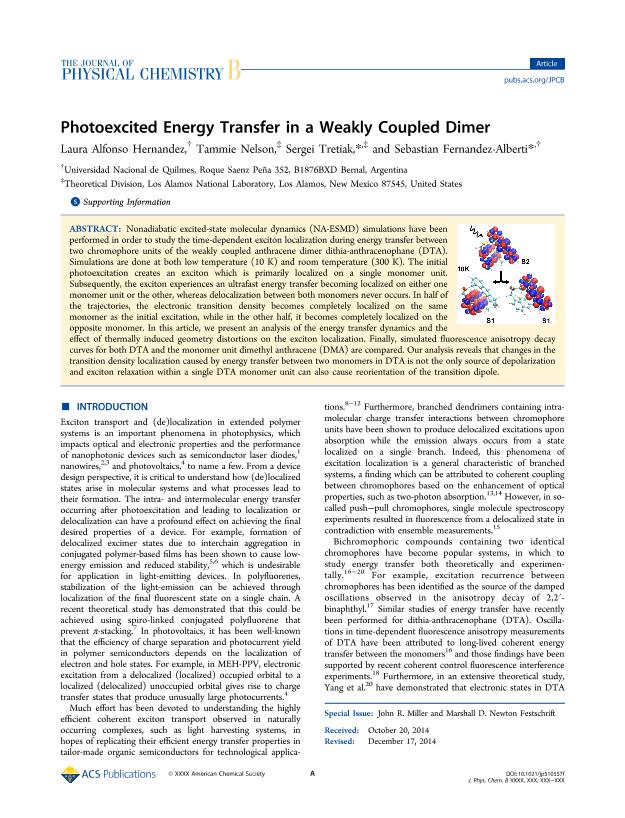Artículo
Photoexcited energy transfer in a weakly coupled dimer
Fecha de publicación:
06/2015
Editorial:
American Chemical Society
Revista:
Journal of Physical Chemistry B
ISSN:
1520-6106
Idioma:
Inglés
Tipo de recurso:
Artículo publicado
Clasificación temática:
Resumen
Nonadiabatic excited-state molecular dynamics (NA-ESMD) simulations have been performed in order to study the time-dependent exciton localization during energy transfer between two chromophore units of the weakly coupled anthracene dimer dithia-anthracenophane (DTA). Simulations are done at both low temperature (10 K) and room temperature (300 K). The initial photoexcitation creates an exciton which is primarily localized on a single monomer unit. Subsequently, the exciton experiences an ultrafast energy transfer becoming localized on either one monomer unit or the other, whereas delocalization between both monomers never occurs. In half of the trajectories, the electronic transition density becomes completely localized on the same monomer as the initial excitation, while in the other half, it becomes completely localized on the opposite monomer. In this article, we present an analysis of the energy transfer dynamics and the effect of thermally induced geometry distortions on the exciton localization. Finally, simulated fluorescence anisotropy decay curves for both DTA and the monomer unit dimethyl anthracene (DMA) are compared. Our analysis reveals that changes in the transition density localization caused by energy transfer between two monomers in DTA is not the only source of depolarization and exciton relaxation within a single DTA monomer unit can also cause reorientation of the transition dipole.
Palabras clave:
Non-Adiabatic Molecular Dynamics
,
Conjugated Molecules
,
Excited States
Archivos asociados
Licencia
Identificadores
Colecciones
Articulos(SEDE CENTRAL)
Articulos de SEDE CENTRAL
Articulos de SEDE CENTRAL
Citación
Alfonso Hernandez, Laura; Nelson, Tammie; Tretiak, Sergei; Fernández Alberti, Sebastián; Photoexcited energy transfer in a weakly coupled dimer; American Chemical Society; Journal of Physical Chemistry B; 119; 24; 6-2015; 7242-7252
Compartir
Altmétricas




